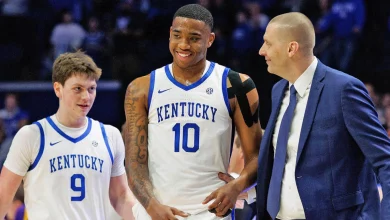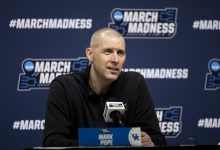Oklahoma GM Jim Nagy explains that OU chooses not to overspend on 5-star recruits, emphasizing value, development, and sustainable team-building over excessive recruiting expenses.

In the competitive landscape of college football, recruiting stands as a critical factor for success. Programs vie for top-tier talent, often engaging in fierce battles to secure 5-star recruits—the highest ranking for high school prospects—who are perceived as future stars and potential game-changers. However, the University of Oklahoma’s General Manager (GM), Jim Nagy, has articulated a different philosophy. He emphasizes that Oklahoma chooses not to overspend on these highly rated recruits, instead focusing on value, player development, and sustainable team-building strategies.
This perspective challenges the conventional wisdom that more money and aggressive recruiting tactics invariably lead to better results. Nagy’s stance reflects a strategic, long-term approach rooted in building a resilient program that prioritizes athletic and personal growth over immediate, costly recruiting splurges.
This comprehensive analysis explores the rationale behind OU’s approach, the broader context of recruiting strategies, Nagy’s philosophy, and how this mindset impacts Oklahoma’s football program and its competitiveness.
The Context of College Football Recruiting
The Allure of 5-Star Recruits
In college football, recruiting rankings are a prominent metric of a program’s perceived success and future potential. A 5-star recruit is awarded based on athletic ability, talent, physical attributes, and potential to excel at the collegiate level. These prospects often come with scholarship offers from multiple powerhouse programs, and their commitment can significantly boost a team’s prospects.
The Myth of Overspending
In the past, some programs have engaged in “pay-for-play” or financial incentives—sometimes crossing ethical boundaries—to secure top recruits. While NCAA regulations prohibit outright payments for recruits, the perception persists that spending large sums on recruiting trips, NIL (Name, Image, Likeness) deals, or other incentives can sway prospects. This has led to debates about whether overspending is necessary or sustainable.
The Risks of Overspending
Overinvestment in recruiting can have several downsides:
Financial Strain: Excessive spending can strain budgets, especially for programs with limited resources.
Sustainability Issues: Relying heavily on recruiting high-cost players may not translate into long-term success if those players do not develop or fit into the team culture.
Recruitment Arms Race: Overspending can trigger an arms race, leading to inflated recruiting budgets across conferences, diminishing competitive balance.
Player Development Concerns: Focusing solely on recruiting high-rated players may sometimes neglect the importance of developing existing talent.
Jim Nagy’s Philosophy
Background of Jim Nagy
Jim Nagy, a well-respected talent evaluator, has served as the executive director of the Senior Bowl, a premier showcase for college players transitioning to the NFL. His insights into player evaluation and team building are informed by a long history of assessing talent and understanding team needs.
Core Beliefs
Nagy’s philosophy regarding recruiting and team building is grounded in several core principles:
Value Over Price: Prioritizing players who offer the best value rather than those with the highest rankings or price tags.
Development Focus: Believing that coaching, player development, and a strong program culture are more impactful than initial talent alone.
Long-Term Sustainability: Building a team that can sustain success over time without excessive spending.
Smart Recruiting: Identifying undervalued or overlooked prospects who fit the program’s identity and needs.
Why OU Avoids Overspending
Nagy emphasizes that Oklahoma’s approach aligns with these principles. The program chooses to:
Focus on players who fit the team culture and system.
Invest wisely in recruiting efforts without unnecessary financial excess.
Prioritize developing players who may not be five-star prospects but have high potential and work ethic.
Avoid the trap of relying solely on high-profile recruits that may not develop as expected.
The Strategic Rationale for Oklahoma’s Approach
Emphasis on Player Development
Oklahoma has a storied history of developing talent into NFL-caliber players. Coaches at OU focus on refining skills, instilling discipline, and fostering a culture of growth. This approach means that even players with lower initial rankings can become key contributors through hard work and proper coaching.
Cost-Effectiveness
By not overspending on recruiting, Oklahoma can allocate resources toward facilities, coaching staff, player health, and academic support—investments that have long-term benefits. This balanced approach ensures the program remains financially sustainable and competitive.
Avoiding the Recruiting Arms Race
Excessive spending on recruiting can trigger an arms race among rival programs, leading to inflated recruiting expenses across conferences. Oklahoma’s stance helps maintain a level playing field, emphasizing talent evaluation and player development over financial muscle.
Building a Cohesive Team Culture
Nagy and Oklahoma prioritize team chemistry, leadership, and character traits—elements that can sometimes be overlooked in the chase for five-star talent. This focus helps build a resilient, disciplined team capable of performing under pressure.
The Reality of Recruiting and NIL
In today’s college football landscape, NIL deals have introduced new dynamics. While some programs leverage NIL to attract top talent, Oklahoma’s approach remains rooted in valuing players who are committed to developing and fitting into the team culture, rather than solely chasing the highest NIL payouts or recruiting hype.
The Evidence: Oklahoma’s Success Without Overspending
Consistent Competitiveness
Oklahoma has maintained a high level of competitiveness in the Big 12 and nationally, often competing for conference titles and playoff spots despite not always spending the most on recruiting.
Developing Underestimated Players
Many key contributors and NFL players from OU were not five-star prospects coming out of high school. This underscores the effectiveness of Oklahoma’s development philosophy.
Achieving Results with Strategic Recruiting
OU’s recruiting success lies in identifying undervalued prospects, building relationships, and emphasizing player potential rather than chasing hype. This approach has resulted in a roster filled with players who embody grit, athleticism, and coachability.
Challenges and Criticisms
The Pressure to Compete
Some critics argue that without overspending, Oklahoma risks falling behind powerhouse programs that prioritize high-profile recruits. However, Oklahoma’s track record demonstrates that strategic recruiting and development can sustain success.
The NIL Factor
The evolving NIL landscape complicates recruiting strategies. While some programs use NIL deals to attract top talent, Oklahoma’s approach emphasizes holistic player evaluation, focusing on character and fit.
Balancing Short-Term Wins and Long-Term Success
Critics may question whether this philosophy sacrifices immediate wins for long-term stability. Yet, Oklahoma’s consistent competitiveness suggests that value-driven recruiting can deliver both.
The Broader Implications for College Football
A Model for Sustainable Success
Nagy’s philosophy offers a blueprint for programs seeking sustainable success without engaging in an expensive recruiting arms race. It emphasizes smart evaluation, player development, and team culture.
Ethical and Regulatory Considerations
By avoiding overspending, Oklahoma aligns with NCAA regulations and ethical standards, reducing risks associated with recruiting violations or pay-for-play allegations.
Impact on Recruiting Strategies
This approach encourages programs to invest in comprehensive scouting, analytics, and player development infrastructure, rather than simply increasing recruiting budgets.
Future Outlook
Continued Emphasis on Development
Oklahoma’s commitment to developing talent will likely remain central to its recruiting philosophy. The program will continue seeking undervalued prospects who can thrive under OU’s coaching staff.
Adapting to NIL and Transfer Portal Dynamics
As NIL and transfer portal options evolve, Oklahoma’s pragmatic, value-oriented approach positions it well to adapt and compete effectively.
Maintaining Competitive Edge
By focusing on sustainable practices, OU can maintain its competitive edge, winning games, developing NFL talent, and building a resilient program aligned with its values.
Jim Nagy’s explanation of Oklahoma’s approach to recruiting—choosing not to overspend on 5-star recruits—reflects a strategic, values-driven philosophy rooted in long-term success. This approach emphasizes the importance of player development, team culture, and sustainable resource allocation over the allure of high-profile, costly recruiting battles.
OU’s success demonstrates that a program can achieve excellence through smart evaluation, disciplined coaching, and nurturing undervalued talent. In an era where college football faces financial pressures, ethical questions, and evolving NIL regulations, Oklahoma’s model offers a compelling blueprint for sustainable, competitive success. Nagy’s insights remind us that in football, as in many pursuits, quality, character, and development often trump the pursuit of instant riches.









